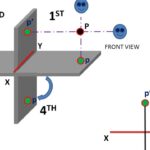Problem-1 Projection of Points – Draw the projection of points, the position of as per data given below:
(1)A point ‘P’ 25 mm above H.P. and 20 mm behind V.P.
(2)A point ‘Q’ 20 mm below H.P. and 25 mm behind V.P.
(3)A point ‘R’ 25 mm below H.P. and 20 mm in front of V.P.
(4)A point ‘S’ 20 mm above H.P. and 25 mm in front of V.P.
(5)A point ‘T’ on H.P. and 25 mm in front of V.P.
(6)A point ‘U’ on H.P. and 25 mm behind V.P.
(7)A point ‘V’ on V.P. and 20 mm above H.P.
(8)A point ‘W’ on V.P. and 20 mm below H.P.
(9)A point ‘X’ on H.P. as well as V.P. both.

Procedure:
Step-1 Draw a horizontal line, which is x-y line of some suitable length.
Step-2 Point P is 25 mm above H.P. and 20 mm behind V.P. So it is in 2nd quadrant and so on a single vertical line above & from x-y line, mark a point p’ at the distance 25 mm and point p at the distance 20 mm on it. Point p’ is front view & the point p is top view of the point P.
Step-3 Point Q is 20 mm below H.P. and 25 mm behind V.P, so it is in 3rd quadrant. So draw a vertical line on both sides of the x-y line. On this vertical line, mark a point q’ 20 mm below x-y line and a point q 25 mm above x-y line. Point q’ is front view & the point q is top view of the point Q.
Step-4 Point R is 25 mm below H.P. and 20 mm in front of V.P. So it is in the 4th quadrant. Draw a vertical line below & from x-y line. On this line mark a point r’ at the distance 25 mm and a point r is at the distance 20 mm from x-y line. Point r’ is front view & the point r is top view of the point R.
Step-5 Point S is 20 mm above H.P. and 25 mm in front of V.P. So it is in 1st quadrant. Draw a vertical line on both sides of the x-y line. On this vertical line, mark a point s’ at the distance 20 mm above the x-y line & a point s at the distance 25 mm below the x-y line. Point s’ is front view & the point s is top view of the point S.
Step-6 Point T is on H.P. and 25 mm in front of V.P. So it is in 1st quadrant but on H.P. Draw a vertical line below & from x-y line. Mark a point t’ on the point of intersection of the x-y line and the previously drawn vertical line & mark a point t on the vertical line at the distance 25 mm below x-y line. Point t’ is front view & point t is top view of the point T.
Step-7 Point U is on H.P. and 25 mm behind V.P. So it is 2nd quadrant but on H.P. Draw a vertical line above & from x-y line. Mark a point u’ on the point of intersection of the x-y line and the previously drawn vertical line & mark a point u on the vertical line at the distance 25 mm above x-y line. Point u’ is front view & point u is top view of the point U.
Step-8 Point V is on V.P. and 20 mm above H.P. So it is in 1st quadrant but on V.P. Draw a vertical line above & from x-y line. Mark a point v on the point of intersection of the x-y line and the previously drawn vertical line & mark a point v’ on the vertical line at the distance 20 mm above x-y line. Point v’ is front view & point v is top view of the point V.
Step-9 Point W is on V.P. and 20 mm below H.P. So it is in 4th quadrant but on V.P. Draw a vertical line below & from x-y line. Mark a point w on the point of intersection of the x-y line and the previously drawn vertical line & mark a point w’ on the vertical line at the distance 20 mm below x-y line. Point w’ is front view & point w is top view of the point W.
Step-10 Point X is on H.P. as well as V.P. both. So it is on the x-y line. Mark a point on the x-y line and give the names x’ & x on this same point. Point x’ is front view & point x is top view of the point X.
Step-11 Give the dimensions by any one method of dimensions to all the points as shown into the figure.


